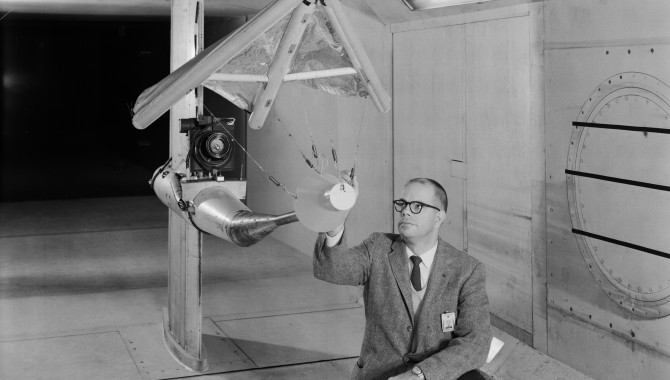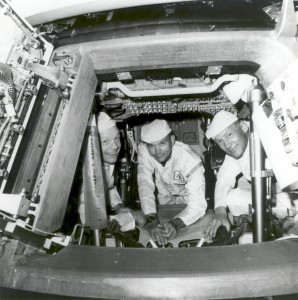
By Howard E. McCurdy
Imagine for a moment that high-ranking government officials enthusiastically embrace a plan to send Americans to the moon as part of an effort that will lead eventually to human expeditions to Mars. The officials charge NASA with the task of mobilizing the nation to achieve this goal. At first, the Agency struggles to achieve it. Efforts to produce a succession of robotic precursors falter. The rocket selected to dispatch the crew is not safe. The crew’s space capsule cannot land as planned. The program suffers cost overruns and schedule delays. The White House and Congress refuse to provide extra funds; support for ventures beyond the moon dwindles. The Agency reorganizes itself.

Peering from the Apollo 11 hatch while conducting a crew compartment fit and functional check in their command module are, from left, Neil Armstrong, commander; Michael Collins, command module pilot; and Buzz Aldrin, lunar module pilot. Lessons from Gemini and large-scale project management aided Project Apollo’s success.
Photo Credit: NASA
Does this sound familiar? Although it may seem to describe the current challenges facing NASA employees as they attempt to launch the Vision for Space Exploration, it is in fact a recounting of the difficulties encountered nearly fifty years ago as the original race to the moon began. The response of NASA officials at that time contains important lessons for efforts under way now.
In recalling what is often termed NASA’s “finest hour,” people tend to mythologize the Apollo landings and the successful efforts to overcome difficulties—most notably those that afflicted the flight of Apollo 13. Yet the effort to surmount earlier difficulties, especially those affecting the Gemini flight program, had a much greater effect upon NASA and transformed the Agency in ways that made the lunar landings possible.
Project Gemini, approved in late 1961, served as a bridge between the Mercury project and the larger goal of reaching the moon. NASA flew ten piloted Gemini missions in 1965 and 1966. Concurrently, NASA dispatched nine Ranger spacecraft to the moon, robotic precursors to the human missions that would follow. Both projects endured significant troubles from the start. The resolution of those difficulties reshaped NASA and enhanced its capacity for effective project management. The NASA that reached the moon in 1969 was significantly different from the institution that began Project Gemini in late 1961.
Government officials approved Project Ranger as a means of obtaining close-up pictures of the lunar surface. The first six Ranger spacecraft failed to complete their missions. Balky rockets, faulty spacecraft, and inaccurate trajectories produced six successive mishaps. Congress launched an investigation and blamed the failures on deficient project management.
NASA officials selected the Titan II launch vehicle, being developed as an air force missile, to carry the Gemini astronauts into space. The rocket oscillated badly. Half of the first twenty test fights failed to meet expectations. Officials at the Johnson Space Center (then the Manned Spacecraft Center) called the rocket unfit for human flight. For the return to Earth, engineers designed a paraglider that would inflate upon descent and guide the space capsule to a smooth touchdown on land. When the test program produced more wing-load problems than controlled descents, NASA officials installed parachutes and reenlisted the U.S. Navy for another series of retrievals at sea.
The cost of Project Gemini grew by more than 40 percent over early estimates. NASA Administrator James Webb asked President John F. Kennedy for extra funds to help the program achieve its objectives. Kennedy rejected Webb’s request and Congress cut NASA’s appropriation by 3 percent. As Congress and the White House cut, NASA planners began to formulate a post-Apollo space program that would include a 1986 human expedition to Mars. In 1964, Webb prepared President Lyndon Johnson for the financial commitments that this effort would entail. Johnson refused to be drawn in. He provided the funds to complete the objective of landing Americans on the moon but declined to provide any significant funding for activities beyond.
Commenting on the troubles faced by the people working on Project Gemini, the authors of the comprehensive history On the Shoulders of Titans conclude that “this picture of a smoothly meshed team moving from success to success, although true enough for the last six months of the program, slighted the obstinate technical and managerial problems that had to be surmounted before the happy outcome was reached.”
Developing NASA’s Culture
How did NASA officials respond to these problems and setbacks? At the start, the Agency relied upon a strong tradition of in-house technical capability. It had an extensive corps of government employees who understood the intricacies of spacecraft design, landing systems, rocketry, and aerodynamics. NASA officials sustained this technical capability by completing a certain amount of work in house, recruiting what they thought to be exceptional people, giving them a great deal of discretion, allowing them to take risks and fail, and providing them with new and challenging assignments.
In-house work encouraged NASA employees to be technically competent. Most people remember the extensive training that astronauts received before their voyages, but NASA’s leadership trained its engineers and scientists as well. Engineers and scientists practiced their technical skills by working on real hardware, conducting tests, training astronauts, operating spacecraft, and doing research. As a result, NASA maintained a corps of professional employees who knew as much—if not more—about space flight and rocketry than any other group of people on the planet.
Second, NASA executives like James Webb looked outside the Gemini and Apollo projects for management practices that could be used to control schedules, monitor costs, regulate design changes, and ensure performance. They learned that complex projects worked best when governed by a single center engaged in systems integration. Webb turned to the U.S. Air Force ballistic missile program, which had the strongest tradition of large-scale systems management, and imported a succession of air force officers and contract employees who knew how the system worked. It took two major reorganizations and plenty of perseverance to install the system in NASA, but by the mid- 1960s the Agency was institutionally prepared to complete the Gemini project and move toward the moon landings.

W.C. Sleeman, Jr., inspecting a model of the paraglider proposed for use in Project Gemini. The wing suffered a number of problems and was later canceled, but the team learned from the failure, which helped Project Gemini’s eventual success.
Photo Credit: NASA
Third, the Agency maintained a special relationship with its contractors. Agency policy dictated that NASA employees use private contractors to build the spacecraft, rockets, landing systems, and other components of Project Gemini. Yet NASA employees did not defer to contractors. Relying upon the technical capability inside NASA and the strong centers of in-house systems integration, NASA managers penetrated and controlled contractors to an unusual degree. One rocket scientist likened the relationship between NASA and its contractors to what one would expect to find between a professor and his or her students.
Together, these practices formed what came to be known as the NASA organizational culture: in-house technical capability, appropriate management techniques, and carefully maintained, close relationships with contractors. If a healthy organizational culture consists of the practices and values that help the organization accomplish its tasks, then NASA’s culture was unquestionably a healthy one. It helped the Agency complete the moon landings—on schedule and within the estimated cost—and supported a succession of successful missions to the moon, Mars, and the outer planets using robotic spacecraft.
Maintaining NASA’s Capabilities
When NASA strays from these practices, it invites trouble. The temptations to stray are considerable. Bureaucratic procedures, excessive oversight, aversion to risk, independent field centers, and unwarranted confidence all conspire to undermine healthy cultures. A recent survey conducted by NASA’s History Office confirms that agency employees worry about issues such as these, although employees still view the Agency as an exceptional place.
History suggests that there is no substitute for in-house technical capability. It is the foundation upon which all other practices rest. Without it, NASA would cease to be a research and development organization. In the 1960s, people like Max Faget, Christopher C. Kraft, Robert R. Gilruth, George M. Low, Wernher von Braun, Eugene F. Kranz, George Mueller, and many others helped preserve that capability. Respondents to the 2006 History Office survey believe that NASA still recruits exceptional people but does not give them enough hands-on work to keep them sharp. By a six-to-one margin, NASA professional employees agree that the Agency “has turned over too much of its basic engineering and science work to contractors.”
Experience also reveals that individual space missions suffer when they lack a single strong center of program integration. Large-scale systems management provided such a center for the moon race, transforming the troubles of Project Gemini into the achievements of Project Apollo. Historian Stephen Johnson has characterized the use of large-scale systems management during the moon race as “the secret of Apollo.” Yet it is not the only way to achieve program integration. A recent succession of low-cost projects demonstrated that “skunk works” techniques provide a worthy substitute for the more formal practices associated with systems management. Scientists at NASA’s Jet Propulsion Laboratory used skunk works techniques to complete the Pathfinder project; officials at the Applied Physics Laboratory used them to complete the NEAR-Shoemaker mission. Space entrepreneurs have adopted them in pursuit of goals like the X PRIZE. Basically, the skunk works approach substitutes small, tightly organized teams with a high capacity for interpersonal communication for the formal control strategies contained in systems management. Lots of organizations use it.
NASA’s relationship with contractors is still evolving. In the beginning, when space exploration was new, NASA attracted a disproportionate share of the world’s best spacecraft engineers and rocket scientists. Today, that talent is more widely dispersed, and NASA officials face substantial pressure to contract out their work. External organizations have substantial technical capability, but their institutional practices do not always match those found in NASA. I recently completed an analysis of twenty-three low-cost NASA projects conducted between 1992 and 2005. One-third of the projects were completed in house; two-thirds were completed by contractors. Projects that followed NASA’s historic practices had a 100 percent success rate. They possessed a single center of program integration, funding commensurate with project complexity (not too little given the complexity of the mission), and a culture of technical competence. Where projects violated two or more of those precepts, they failed 50 percent of the time. Violation of the precepts occurred far more frequently on projects contracted out than ones done in house.
A half-century of space flight has created a storehouse of experience that can be applied to future challenges. There are many ways to manage a space expedition and only a few ways to do it right. The civil space program has been well served by its tradition of in-house technical capability, strong centers of integration, and the insistence that contractors follow sound practices. Yet the temptation to compromise remains strong. Where that occurs, trouble invariably follows. NASA has the opportunity to achieve great new goals. Its history suggests that this will not be easy, but it is feasible. As President Kennedy noted in launching the modern space program, we do these things “not because they are easy, but because they are hard.”










